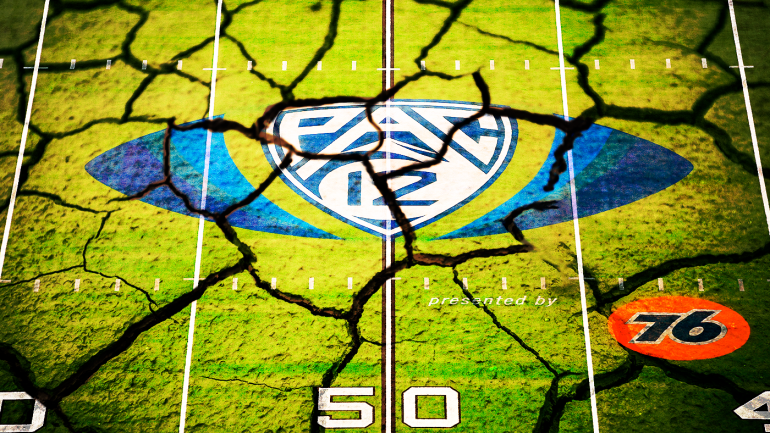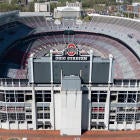
The stealthiness of realignment these days is only surpassed by its audacity. USC and UCLA broke a 94-year relationship with the Pac-12 on Thursday despite serving as foundational rocks of West Coast athletics. And immediately, the conversation was less about the move itself -- we're kind of used to that sort of thing by now -- and more about its implications.
The 32 teams in the SEC and Big Ten now control most of the money, resources, rules and airways. (Ask the charter companies that will be hauling USC and UCLA athletes 3,000 miles to New Jersey for games against Rutgers.) The collection of brands in those two leagues is so thick right now, it could legitimately stage its own playoff.
If Cincinnati goes undefeated again, will the only entity calling the shots (television) care if the Bearcats are left out of the College Football Playoff? Of course not. And forget about needing a unanimous vote for CFP expansion in 2026. The SEC and Big Ten are calling the shots there, too.
This is consolidation on a seismic scale. It's the Big Ten's answer to the SEC adding Texas and Oklahoma less than a year ago.
It has also created the last desperate chance for other programs to grab the gold-plated brass ring and link up with the two superconferences set to rule the (college sports) world. (Talking to you, Clemson, Florida State, Miami and Notre Dame.)
Sadly, we have gone from #Pac12AfterDark to, perhaps, #Pac12GoingDark.
Yes, that's in play, too. The last major conference to disintegrate was the Big East in 2013. This is different. This is major college football west of the Rockies. This is a Power Five league … or what used to be a Power Five league.
It's a Power Two now. Get used to it.
Also, "The Grandaddy of Them All" is showing its age. The prestige of the Rose Bowl is suddenly on life support.
Call it karma, synergy or irony: Former Pac-12 commissioner Larry Scott's contract expired Thursday, the same day his old league began falling apart.
This was supposed to take years, this reshaping of major-college football. Heck, it took 10 years between the upheaval of 2010-11 to the announcement that Texas and Oklahoma were headed to the SEC.
But now, less than a year after that shocker, USC and UCLA to the Big Ten took less than a day. Only hours after the migration of the Trojans and Bruins broke, they had formally applied for Big Ten membership. Shortly thereafter, the Big Ten presidents voted to accept.
How fast was it? Stop to consider Lincoln Riley is affiliated with his fourth conference since losing to Oklahoma State last November.
The Big Ten made this move likely within a month of a forthcoming media rights deal announcement. It has already come to a primary rights agreement with Fox, and industry sources told CBS Sports it would not be surprising if Fox declined to partner with either the Big 12 or Pac-12 in new deals going forward.
With the SEC starting a new, lucrative and comprehensive deal with ESPN in 2024, the Big Ten had to answer. Both conferences will have the same amount of teams (16) once their high-profile additions officially become league members.
How fast did all of it happen? Pac-12 commissioner George Kliavkoff said this a few days ago about the Big Ten's new TV contract: "I think the Big Ten is going to crush it, and we are rooting for them because I think they will set the market."
(Let's assume he knew nothing of the tsunami about to crash on his West Coast shores.)
As for what's next …
Realignment is just getting started
Earlier this week, CBS Sports quoted a high-ranking sports TV industry source on the potential for conference realignment: "Everybody is talking to everybody." That was before news of USC and UCLA broke the internet.
Clemson, Florida State and Miami have a decision to make. Industry sources believe it's a reasonable expectation that the ACC powers had previously inquired with the SEC, possibly even the Big Ten.
The possibility of $80 million-$100 million in annual media rights trumps anything the ACC can produce through the length of the current TV deal that ends in 2036. However, even a hefty penalty for breaking the grant of rights – rumored to be more than $50 million -- could be financed over that period. Those schools would still come out ahead of what they're making in the ACC.
After Texas and Oklahoma roosted in the SEC, there were only a handful of schools that had options in realignment: Clemson, Florida State, Notre Dame, Miami, USC and UCLA. Along with Notre Dame, USC probably had the most leverage.
"They've, for decades, thought they brought more to the Pac-12 than the Pac-12 brought to them," said one administrator with extensive Pac-12 experience of USC. "They've been threatening things for ages."
Part of Pac-12 football's charm -- beach, sun, weather, mountains, -- was also part of its curse. West Coasters tend to go to the beach or mountains first if the local team isn't killing it. Sometimes, even if they are winning. Football is not an obsession out West. Two of the few schools in the Pac-12 where it actually draws are now in a conference that consumes college football along with a lot of bratwurst.
It is reasonable to ask whether this would have happened if the Pac-12 had been more competitive recently on the field. The league has not made the CFP since 2017.
It has been 17 years since the Pac-12 won a national championship -- ironically, USC in 2004 -- and it's fair to wonder whether the league will ever have an opportunity to win another.
At USC, that future became increasingly unsustainable at a school whose alumni felt was being dragged down by the league.
As Pac-12 presidents and athletic directors met Thursday night, there was still the question of whether Oregon and Washington would be next to leave. They're the two next-best brands in the Pac-12.
Does the Pac-12 have a future?
If the day's top story is the Big Ten consolidating power alongside the SEC, its second headline is the Pac-12 perhaps going away for good.
We should have been warned when ESPN thought nothing of relegating a partner (Big 12) to second-class status by at least rubber stamping Texas and Oklahoma joining another partner (SEC). For a few tenuous weeks, it felt as if the Big 12 would disintegrate, and then it added BYU, Cincinnati, Houston and UCF.
The Pac-12's situation seems worse. With Thursday's development, the league is in danger of imploding upon itself. Two high-profile sources told CBS Sports this may be it for the 107-year old conference.
Its centerpieces -- the Los Angeles schools -- has been ripped away. Its next-biggest market is Phoenix where Arizona State is under NCAA investigation for major violations. Arizona is one of the Pac-12's worst college football programs at the moment with basketball digging out of its own NCAA issues.
For now, there is no interest from the Big 12 to take any Pac-12 schools. When a chance presented itself Thursday for the Big 12 board of directors to discuss these developments, one high-ranking Big 12 official said, "Why?"
That doesn't mean the Arizona schools may not eventually migrate to the new Big 12. There may be some value with the Phoenix market and being able to expand the conference's membership to 14. It does mean there is a reckoning coming for the Pac-12 where -- for the most part -- the appetite for football pales in comparison to the rest of the country.
"We're not obsessed with that right now," said Lawrence Schovanek, president of Texas Tech, when asked about realignment on Wednesday, "but nobody has said having 12 members in the Big 12 is the magic number."
The Big 12 looks rather stable right now.
Oregon and Washington might be next with a jump to the Big Ten likely at least a consideration. That conjures the cringeworthy prospect of some Pac-12 schools then having to join the Mountain West to find a home.
The Notre Dame question
If Notre Dame is committed to independence, this an(other) inflection point. The SEC simply is not an option. Neither is the ACC, despite the Fighting Irish's current affiliation with the league. The ACC simply cannot match the payouts likely to come from the Big Ten, even if Notre Dame was to join the fold.
Notre Dame's dance with the Big Ten goes back decades. That's not to say this would be the Irish's last chance to get in a conference, but it certainly would be a heck of a chance to do so.
Notre Dame has always valued its scheduling flexibility, but it has given up some of that in its current alignment with the ACC (5-6 ACC games per season). Does a shot at a nine-figure annual payout change all that?
Addition and subtraction?
Remember the Big 12 almost going away last year? That was heartless, yes. Now, consider a similar scenario if, say, the SEC wanted to make room for the likes of Clemson or Miami
Would it simply eject a couple of underperforming schools? Would the Big Ten consider doing the same if it had more prominent replacements lined up?
One conference official reminded me that schools commit to a conference, not the other way around.
So, out with Vanderbilt and Missouri, in with Clemson and Miami? Out with Indiana and Purdue, in with Oregon and Washington?
The Big East booted Temple in 2001 for underperformance. Kansas State was on the verge of dropping football -- if the Big Eight didn't drop it first -- before Bill Snyder arrived in 1989.
It's a longshot, but judging by the events of Thursday, the scenario is not out of the question.
Rose Bowl-ed over
With USC and UCLA, not only is the Big Ten now in the Pacific Time Zone, it has teams that have played in 16 of the last 19 Rose Bowls. That raises the once-unthinkable prospect of the future of the Rose Bowl itself. USC and UCLA have represented the Pac-12 in a combined 46 of 108 Rose Bowls (43%).
If there is no Pac-12, there is no participant in the Rose Bowl. If there is a wounded, diminished Pac-12 that somehow lives on, does the Rose Bowl want to remain partners?
"They just destroyed the Rose Bowl, too, as a Pac-12 asset," said one Pac-12 source.





















